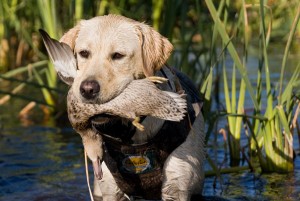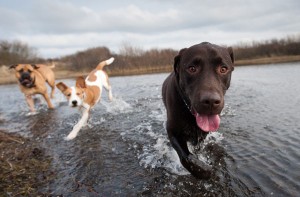June 25, 2012
By James B. Spencer
 Many retrieverites assume the blind retrieve has always been with us, as if Eve taught Adam to fetch apples, so she could remain in her lawn chair while directing him (by whistling and waving her arms). Later, she found dogs were more trainable — fewer "no-goes," "slipped whistles," and "cast refusals."
Many retrieverites assume the blind retrieve has always been with us, as if Eve taught Adam to fetch apples, so she could remain in her lawn chair while directing him (by whistling and waving her arms). Later, she found dogs were more trainable — fewer "no-goes," "slipped whistles," and "cast refusals."
Actually, retriever folks had to make do without the blind retrieve until sometime in the early 1920s, when David D. Elliot, a Scottish gamekeeper/dog trainer, chanced upon it while goofing off. Probably exhausted from the daily grind, he took a day off and — speak of a postman's holiday — spectated at a nearby herding dog trial. He saw one handler after another send his dog (probably a border collie) on a long trip to the far side of a flock of sheep (lining). Next, the handler whistled and his dog turned, sat and awaited further instruction. Then, the handler gave a wave of his arm that sent the dog scampering behind the herd (casting). After again stopping his dog behind the herd, he tooted another whistle that brought the dog towards him with the flock ahead of it (more casting).
Line 'Em Up
Dave watched handlers direct their distant dogs this way all day. At some point, it occurred to our hooky-playing hero that, if he could train his retrievers to take those whistle commands and arm signals, he could "wipe eyes" in British retriever field trials.
Advertisement
Huh, he could what? "Wipe eyes?"
In British retriever trials, then and now, several handler/dog teams are positioned among a line of shooters. The entire line moves forward, flushing, shooting and retrieving birds as they go. Frequently, multiple birds flush at once all up and down the line, so many that no dog could mark every fall. The judges designate which dog is to retrieve which bird. If one dog fails on a specific bird, the judges give another dog a go at it. If that dog succeeds, he is said to have "wiped the eye" of the other dog. This was a brag factor among handlers, and a great way to win field trials.
It was pretty chancy. If the first dog failed, your dog may or may not have seen that bird. If he did, he would probably wipe an eye for you; if he didn't, well, he might fail, and you would perhaps watch a third dog wipe both unsuccessful dogs' eyes, which would be big bragging rights.
Advertisement
After learning from herding dog trainers how they taught their dogs this advanced type of handling, the bright and enterprising young Mr. Elliot hurried home and went back to work with renewed enthusiasm. He tried this new handling technique with one of his Labs, and it worked! He also tried it with his string of dogs and it worked over and over, not always with the same speed and success, but well enough. He named this new retrieve an "unseen," because it enables a dog/handler team to pick up a bird the dog hadn't marked.
Young Dave tested it in field trials. He did so well, many other handlers cried "Foul!" But as he won more and more trials all over the British Isles, those who had complained the loudest stopped protesting and started imitating him, with varying degrees of success. But all through the 1920s and into the early '30s, Elliot was the handler to beat.
Incidentally, I learned all this years ago from Elliot's now long out-of-print book, "Training Gun Dogs to Retrieve." Amazingly, he tells this entire story without ever mentioning a single date! But he almost had to have started after WWI, because prior to that flat-coats dominated British trials. Labs only became popular after WWI. Since he mentions only Labs in his narrative, I assume he started in the early '20s after Labs were well established. I also know from other sources, Elliot came to America in the early '30s, after he and his "unseen" were well known.
American Influence
During the '20s, several prominent members of our American aristocracy frequently traveled to the British Isles to hunt and hobnob with the nobility. They learned about Labs and participated in British retriever trials. Mr. and Mrs. Marshall Fields, Averell Harriman, Jay Carlisle and others were among these American luminaries.
Back home, they transformed extensive land holdings into estates, like those of the British landed gentry. They also imported both Labradors and British gamekeepers. Carlisle grabbed the brass ring for his Wingan Kennels on Long Island when he hired Elliot in the early '30s.
These American luminaries also formed the Labrador Retriever Club (LRC) and conducted the first-ever American Kennel Club (AKC) retriever field trial in December 1931, patterned after the British trials most of those folks were long familiar with.
These trials soon began to diverge from the British model for one reason: Over here, we don't suffer the same restrictions on planted birds, dead birds and thrown birds that limit the format to real hunting situations. Our judges could set up marks of any length, involving any set of hazards (terrain and cover variations, wind direction, etc...) and in any sequence and with whatever hazards they saw fit.
As a result, the British "unseen" became our American "blind retrieve." Over there, they "handled" retrievers (via whistle/vocal commands and arm signals) only to birds that had flushed, been shot and had fallen in plain sight, but which the dog had not seen (or remembered). Over here, judges can set up blind retrieves that none of the competing dogs see fall, and then run all dogs identically on the same test, which can require whatever handling skills they want to evaluate.
Full Circle
Over the years, our tests have become so complex and hazard-riddled one might wonder whether the Marquis De Sade was involved in their design, because the judges have to find a winner in about a day and a half from larger and larger entries of better and better bred and trained retrievers. Granted, dogs that succeed in these long and complex field trial tests can also handle ordinary hunting situations. But few hunters want to spend all their free time training a retriever year-round to field trial standards just to have a good hunting dog.
 The post-WWII economic recovery produced a large middle class in America, with leisure time and disposable income for hobbies. Many took to hunting with dogs and needed an off-season dog game. But field trials were way too much for most of them. So the search was on for a simpler game, something more like hunting.
The post-WWII economic recovery produced a large middle class in America, with leisure time and disposable income for hobbies. Many took to hunting with dogs and needed an off-season dog game. But field trials were way too much for most of them. So the search was on for a simpler game, something more like hunting.
In the mid-1980s they made a significant step with non-competitive "hunt tests," designed by hunters with strict limitations on the length and complexity of the judges' tests. But — some thought — why stop there?
Very recently, a group of breeder/trainers re-introduced British-style retriever trials in this country. These are more than "like hunting." They are hunting with your dog, but under judgment!
Jim Spencer's books are available from the WILDFOWL Bookshelf.

